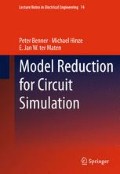Abstract
In this paper, we will give a short motivation for the use of symbolic methods for model order reduction and present some of these techniques. Furthermore, we will discuss the hierarchy usually at hand for circuit design and present a workflow for the exploitation of this hierarchy. By applying it to a simple circuit example, we will show how model order reduction (MOR) methods can be profitably employed.
Access this chapter
Tax calculation will be finalised at checkout
Purchases are for personal use only
Notes
- 1.
In MNA contributions of components to the system typically are of the form \(A^T \cdot f(Bx),\) where A and B are incidence matrices describing the circuit topology and f is a function describing the behavior of the corresponding component. The same expression holds for submodels.
- 2.
x% error here means \({\frac{x}{100}}\) of the maximum magnitude of the reference solution, considered on the entire time interval: \({\frac{x}{100}}\cdot\sup_{t\in[t_0,t_1]}||v_F(t)||_{\infty}.\)
- 3.
The computations were executed on a Dual Quad Xeon E5420 with 2.5 MHz and 16 GB RAM.
- 4.
A ranking is a trade-off between accuracy and efficiency in computation time that estimates the influence of a term in the equation system on the system’s solution.
- 5.
One step provides sufficient accuracy here, since the sources are DC voltage sources.
- 6.
We performed some experiments with a higher number of iteration steps, but the gain of additional accuracy in comparison to the size of the larger system was rather marginal for a number of iteration steps bigger than five.
- 7.
As we are reducing only the single subsystem, this error bound is not limiting the error of the entire circuit’s output Vout to the given values (see Sect. 15.4 and Algorithm 1 for further details).
- 8.
We chose the more accurate model with 66 equations, see Fig. 15.10.
- 9.
A test bench is a simulation test environment. Here, one could take all the rest of the entire circuit as test bench.
- 10.
Of course, one could record the currents as well.
- 11.
By providing the voltages at all k ports, they work as the input to the subsystem. Then the currents flowing into the subsystem at the k ports are defined as the output and will be controlled by the specified error bound.
- 12.
The respective flows are directed towards the interior of each pipe.
References
Antoulas, A.C.: Approximation of Large-Scale Dynamical Systems. SIAM, Philadelphia (2005)
Freund, R.W.: Structure-preserving model order reduction of RCL circuit equations. In: van der Vorst, H., Schilders, W., Rommes, J. (eds.) Model Order Reduction: Theory, Research Aspects and Applications, Mathematics in Industry. Springer, Berlin (2008)
Halfmann, T., Wichmann, T.: Overview of symbolic methods in industrial analog circuit design. Berichte des Fraunhofer ITWM, Nr. 44 (2003)
Halfmann, T., Wichmann, T.: Symbolic methods in industrial analog circuit design. In: Anile, A.M., Ali, G., Mascali, G. (eds.) Scientific Computing in Electrical Engineering. Springer, Berlin (2006)
Lassaux, G., Willcox, K.: Model reduction for active control design using multiple-point Arnoldi methods. AIAA Paper 2003-0616, Presented at 41st Aerospace Sciences Meeting & Exhibit, Reno, NV (2003) URL: http://www.hdl.handle.net/1721.1/3702
Li, R.-C., Bai, Z.: Structure-preserving model reduction using a Krylov subspace projection formulation. Comm. Math. Sci. 3(2), 179–199 (2005)
Miri, A.M.: Ausgleichsvorgänge in Elektroenergiesystemen. Springer, Berlin (2000)
Reis, T.: Systems Theoretic Aspects of PDAEs and Applications to Electrical Circuits. Shaker, Aachen (2006)
Reis, T., Stykel, T.: A survey on model reduction of coupled systems. In: Schilders, W.H.A., van der Voorst, H.A., Rommes, J. (eds.) Model Order Reduction: Theory, Research Aspects and Applications, Mathematics in Industry, vol. 13, pp. 133–155. Springer, Berlin (2008)
Schmidt, O.: Structure-Exploiting Coupled Symbolic-Numerical Model Reduction For Electrical Networks. Ph.D. thesis, TU Kaiserslautern, Cuvillier, Göttingen (2010)
Sommer, R., Halfmann, T., Broz, J.: Automated behavioral modeling and analytical model-order reduction by application of symbolic circuit analysis for multi-physical systems. Simulation Modelling Practice Theory 16, 1024–1039 (2008)
Villena, J.F., Schilders, W.H.A., Silveira, L.M.: Parametric structure-preserving model order reduction. In: Reis, R., Mooney, V., Hasler, P. (eds.) IFIP International Federation for Information Processing, vol. 291, VLSI-SoC: Advanced Topics on Systems on a Chip, pp. 69–88. Springer, Berlin (2009)
Vlach, J., Singhal, K.: Computer Methods for Circuit Analysis and Design, 2nd edn. Van Nostrand Reinhold, New York (1993)
Wichmann, T.: Symbolische Reduktionsverfahren für nichtlineare DAE-Systeme. Shaker, Aachen (2004)
Wichmann, T., Popp, R., Hartong, W., Hedrich, L.: On the simplification of nonlinear DAE systems in analog circuit design. In: Proceedings of CASC’99, Munich, Germany (1999)
Willems, J.C.: The behavioral approach to open and interconnected systems. IEEE Control Systems Magazine 27, 46–99 (2007)
Wolfram, S.: The Mathematica Book, 5th edn. Wolfram Media Incorporated, Champaign (2003)
Analog Insydes website: URL: http://www.analog-insydes.de
SyreNe website: URL: http://www.syrene.org
Acknowledgements
The work reported in this paper has been carried out within the project SyreNe (Systemreduktion für IC Design in der Nanoelektronik [19], Grant no. 03LAPAE6) which is supported by the German Federal Ministry of Education and Research (BMBF). The first named author wants to thank his thesis advisor G.-M. Greuel for additional support. Responsibility for the contents of this publication rests with the authors.
Author information
Authors and Affiliations
Corresponding author
Editor information
Editors and Affiliations
Rights and permissions
Copyright information
© 2011 Springer Science+Business Media B.V.
About this chapter
Cite this chapter
Schmidt, O., Halfmann, T., Lang, P. (2011). Coupling of Numerical and Symbolic Techniques for Model Order Reduction in Circuit Design. In: Benner, P., Hinze, M., ter Maten, E. (eds) Model Reduction for Circuit Simulation. Lecture Notes in Electrical Engineering, vol 74. Springer, Dordrecht. https://doi.org/10.1007/978-94-007-0089-5_15
Download citation
DOI: https://doi.org/10.1007/978-94-007-0089-5_15
Published:
Publisher Name: Springer, Dordrecht
Print ISBN: 978-94-007-0088-8
Online ISBN: 978-94-007-0089-5
eBook Packages: EngineeringEngineering (R0)

